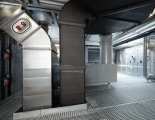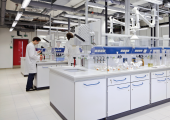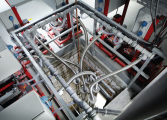 The Institute for Physical Chemistry of Christian-Albrechts University (CAU) at Kiel, Germany, was reconstructed. In particular, the installation of the ventilation system and the associated building automation system was commissioned. The tendering was finally won by the LOYTEC Competence Partner, Dr. Diestel.
The Institute for Physical Chemistry of Christian-Albrechts University (CAU) at Kiel, Germany, was reconstructed. In particular, the installation of the ventilation system and the associated building automation system was commissioned. The tendering was finally won by the LOYTEC Competence Partner, Dr. Diestel.
The laboratory building with its particular requirements for ventilation and air conditioning posed a special challenge for the experts of Dr. Diestel GmbH as well as the selected automation system, because high air exchange rates had to be achieved at low temperature tolerances limitation of humidity. The building contains two cleanrooms, over 30 laboratory rooms, two precision mechanic workshops, a welder shop, an electrical engineering workshop, a wood workshop, and a library.
The automation system aimed at connecting all major devices and displaying system conditions through a clear visualization. One demand was to integrate the automation system into the building management system provided by Kieback & Peter. New data access structures were created to enable quick distribution of malfunction or maintenance messages between users and service personnel and so allow for immediate reaction.
Implementation
For implementing this task, the entire building automation project was divided into two big sections. Kieback & Peter was responsible for the execution of the primary systems (ventilation and heating). They equipped the ventilation system with a LON interface for direct data exchange with room control. The room automation system for cleanrooms, laboratory rooms, and workshops was implemented by Dr. Diestel GmbH. Diestel used LOYTEC’s powerful LINX- 120 Automation Servers, extended with L-IOB I/O Modules. A range of LON volume flow controllers and fire damper messaging are integrated into the IP-852 channel with L-IP Routers and hence are able to communicate via Ethernet/IP with the L-INX Automation Servers. For central data acquisition and reporting, the following software solutions of LOYTEC are used: LWEB-801 Server and LWEB-830 Dream Report as the reporting tool.
Tasks of LOYTEC Components
In particular, the following tasks are accomplished by LOYTEC components in the newly erected building of the Institute for Physical Chemistry at CAU:
Controlling of laser exhaust: For laser exhaust, only limited contingents of air volume are available, eight concurrent exhausts at the maximum. But altogether, 23 exhausts are necessary, spread across the whole building. Through light signals, the current local status of exhaustion is indicated. In addition, the laboratory management staff has visualization at hand, enabling them to take corrective steps in case of a bottleneck.
Room balancing: The entire balancing of the laboratory is visualized by the L-WEB software. This enables quick intervention in case of failure. Simple, slow volume flow controllers are integrated into the laboratory balancing system. Among others, they ascertain the actual air volume for the exhaust units and register the position of the manual throttling at the bottom of the exhaust units. If there are several exhaust units in one room, the room balancing is no longer vague due to the unknown position of the manual throttling. Moreover, previously, one would have required to uphold a higher pressure level within the exhaust air system, which in further consequence would have led to more energy consumption. An example: Previously, with three exhaust units, the inaccuracy could measure up to 300m³/h. This can lead to problems when opening or closing dense smoke control doors.
Control of power-driven fire dampers: The control of power-driven fire dampres (BSK) is accomplished by a separate L-INX Automation Server, interacting with BSK-LON modules. The modules are installed decentralized near to the relating fire dampers in the building. These modules are aggregated via several LON TP/FT-10 channels, packed via L-IP Routers and integrated into the IP-852 (Ethernet/IP) channel. The fire dampers are monitored separately and can also be sent into a maintenance cycle individually with one click. The results are displayed immediately. The conditions of the fire dampers are recorded continuously, so that events or malfunctions can be recorded and analyzed all the time.
Conclusion
Dr. Diestel sums it up: “In using an autonomous integration platform, the L-INX Automation Server, we could react adequately and quickly to the comprehensive interface for implementing peripheral systems of building engineering that you also find in other building projects and that is being specified only in the course of the building progress. This includes building functions such as lifting systems, and chillers. Through open communication of all involved parties demanding tasks could be implemented with the available technology to the satisfaction of the customer.”
Interesting Facts
Devices:LINX-120 ,LIP-3333ECTB, LIOB-150, LIOB-151, LIOB-100, LIOB-101, LWEB-801 Server, LWEB-830 Dream Report
| Location | Kiel, Germany |
| Number of Nodes | NA |
| Topology | NA |
| Companies involved | Dr. Diestel GmbH, Projektleitung Oliver Baron |
| LOYTEC Cpmponents | 2 x LINX-120, 6 x LIP-3333ECTB, 16 x LIOB-150, 3 x LIOB-151, 1 x LIOB-100, 1 x LIOB-101, LWEB-801 Server, LWEB-830 Dream Report |
| LOYTEC Tools |
NA |





